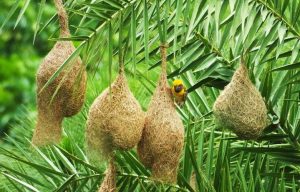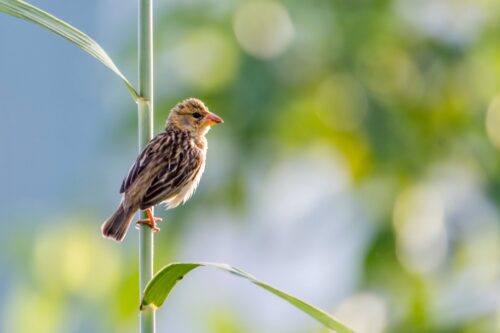In the world of birds Baya birds are considered as master architects. Their nests are built in proper shape and size. As mentioned earlier the male Baya bird invites a female Baya bird to inspect and certify the nest before it is built completely. If a passing female approves the nest, it will mate with the male and start breeding. But the nest is to be completed first. It is said that a single male may be successful in pleasing a number of birds by building a number of approvable nests. Thus the male may have many wives. Isn’t it interesting?
Most of you us have seen the Baya birds – peculiar birds of monsoon season. These beautiful birds are found in many states of India and of course in many other countries of the world. These birds are also found all over Java and Sumatra.
The baya bird is a weaver bird. It weaves its nest that hangs from a tree and swings in air. I have seen many nests of baya birds hanging from a single tree in many rural and sub-urban areas whenever I happened to pass through these areas in monsoon season. Baya bird can build its nest at any suitable place. There is no choice of type of tree. Even electric wires are chosen by these birds to make nests.
The biological name of this bird is Ploceus philippinus. Now you may think that this bird may surely be found in Philippines and that is why it has been named so. But, it is not correct. Baya is not found in Philippines.
These birds are found across South and Southeast Asia and inhabit grassland, cultivated areas, scrub and secondary growths usually near fresh or brackish water.
Naturalists have recognized three geographical races of baya birds found in different parts of India.
These three races are –
- The race P. philippinus is found throughout India.
- The race P. burmanicus is found eastwards into Southeast Asia.
- A third race P. travancoreensis is found in southwest India.
Appearance
These are sparrow sized (15 cm) birds and in their non-breeding plumage, both males and females resemble female house sparrows.
They have a stout conical bill and a short square tail. Non-breeding males and females look alike. They are dark brown streaked in the upper side, plain (unstreaked) whitish in the lower side.
Breeding males have a bright yellow crown and dark brown mask. They have blackish brown bill. Their upper parts are dark brown usually streaked with yellow. The breast is yellow and the lower part is creamy.
Habits of weaver birds
Baya Weavers are social and gregarious birds. They forage in flocks for seeds, both on the plants and on the ground. Flocks fly in close formations, often performing complicated skills.
They are known to pick paddy and other grain in harvested fields. They occasionally damage ripening paddy crops and are therefore sometimes considered as pests. They roost in reed-beds found near the banks of water bodies. They depend on wild grasses such as Guinea Grass (Panicum maximum) as well as crops like paddy for both their food and nesting material.
For nesting material they are known to use strips of sugar cane leaves and strips of other grasses having long leaves. Not alone on seeds they feed on insects also. The seasonal movement of these birds is governed by the availability of food.
Nest Weaving
The breeding season of the Baya Weavers is the monsoon season. These birds nest in the groups of twenty to thirty. Their colonies usually remain near the source of food and water, and yes close to the nesting materials. Their nests are often built hanging in air or over water.
Baya Weavers are best known for their elaborately woven nests. Their pendulous nests are usually retort shaped. These nests have a central nesting chamber and a long vertical tube that leads to a side entrance to the chamber.
The nests of Baya birds are woven with long strips of paddy leaves, rough grasses and long strips torn from palm fronds. Each strip can be 20 to 60cm in length.
A male bird is known to make up to 500 or more trips for bringing nesting material and to complete its nest. These birds use their strong beaks to tear off long leaves and to collect the strands, and to weave them while building their nests.

https://www.archedu.org/blog/anatomy-of-a-nest/
Breeding behavior
It is during breeding season that male baya birds start building their nests. When the nests are partially built, the male bird flaps its wings and calls to the passing females to come and inspect its nest.
Females approve a nest only after proper inspection. Once when a female approves a nest the pairing is established. It is after pairing that the male bird completes its nest including the entrance tunnel.
Though the male bird is solely in-charge of building a nest the female bird too offers cooperation after pairing. It has been reported that the location of the nest matters more for a female bird to make a decision.
A male builds a partial nest and starts female bird for approval. After approval the mating is established. After mating the female lays 2 to 4 eggs that are white in colour. The female incubates them and brings up the brood.
In the world of birds Baya birds are considered as master architects. Their nests are built in proper shape and size. As mentioned earlier the male Baya bird invites a female Baya bird to inspect and certify the nest before it is built completely.
If a passing female approves the nest, it will mate with the male and start breeding. But the nest is to be completed first. It is said that a single male may be successful in pleasing a number of birds by building a number of approvable nests.
Thus the male may have many wives. Isn’t it interesting?
Courtesy –
Feature Image: https://unsplash.com/s/photos/baya-weaver
Image of Nests: https://www.archedu.org/blog/anatomy-of-a-nest/




